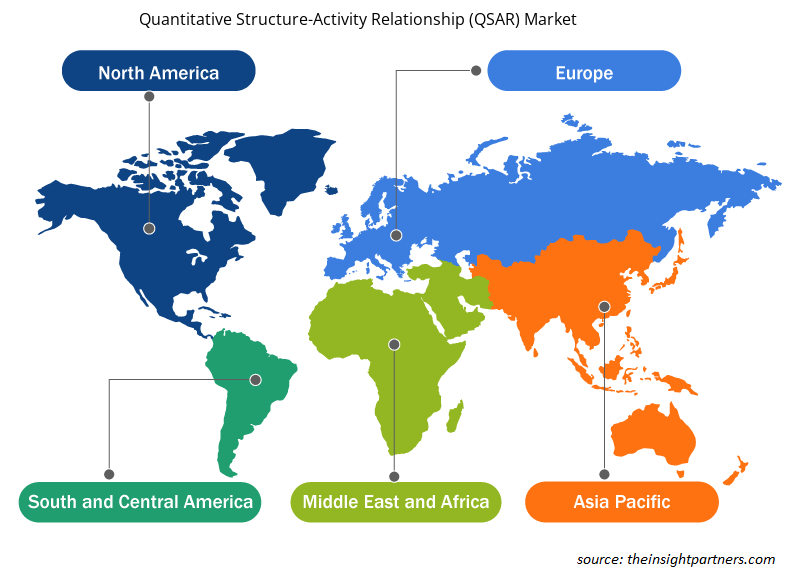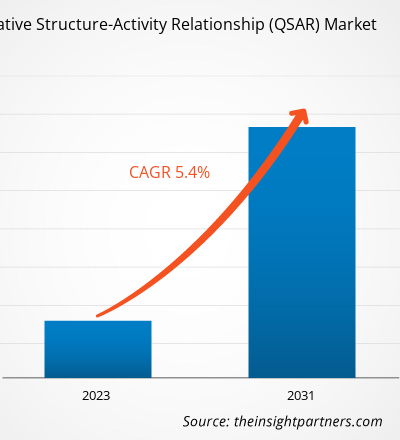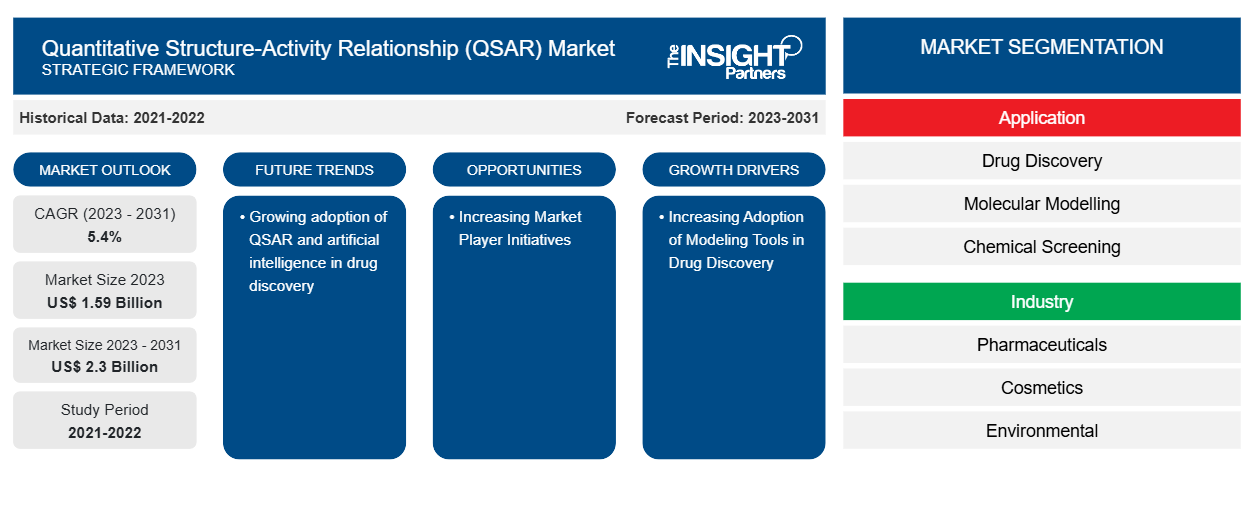La taille du marché de la relation quantitative structure-activité (QSAR) devrait atteindre 2,30 milliards USD d'ici 2031, contre 1,54 milliard USD en 2023. Le marché devrait enregistrer un TCAC de 5,4 % en 2023-2031.QSAR) Market size is projected to reach US$ 2.30 billion by 2031 from US$ 1.54 billion in 2023. The market is expected to register a CAGR of 5.4% in 2023–2031.
L’adoption croissante de la QSAR et de l’intelligence artificielle dans la découverte de médicaments devrait rester une tendance clé du marché des relations quantitatives structure-activité (QSAR).
Analyse de marché de la relation quantitative structure-activité (QSAR)
Une relation quantitative structure-activité (QSAR) est une approche de modélisation informatique ou mathématique permettant de révéler les liens entre les activités biologiques et les propriétés structurelles des composés chimiques. Elle tente de corréler la structure chimique avec une activité à l'aide d'approches statistiques. Les modèles QSAR sont utiles à diverses fins, notamment pour prédire les actions de produits chimiques non testés. En outre, elle permet de hiérarchiser les activités biologiques souhaitées en tant que méthodologie in silico et de réduire ainsi le nombre de produits chimiques candidats à tester avec des expériences in vivo. Les principaux facteurs qui stimulent la croissance du marché sont l'adoption croissante d'outils de modélisation dans la découverte de médicaments et l'augmentation du fardeau économique de la découverte de médicaments. Cependant, le faible taux d'adoption de la technique dans les pays émergents freine la croissance du marché.
Relation quantitative structure-activité (Aperçu)
L'Amérique du Nord est le plus grand marché pour la relation quantitative structure-activité (, les États-Unis détenant la plus grande part de marché, suivis du Canada. Cela peut être attribué au nombre croissant d'activités de recherche et développement, au nombre croissant de startups et à l'augmentation des investissements pour le développement de nouveaux candidats médicaments innovants ciblant les maladies rares et incurables et autres. La demande pour le marché de la région devrait connaître une croissance significative au cours de la période de prévision en raison d'autres facteurs tels que les investissements gouvernementaux dans les infrastructures de santé, la prévalence croissante des maladies chroniques et l'adoption croissante du big data et des outils informatiques de santé.
Personnalisez ce rapport en fonction de vos besoins
Vous bénéficierez d'une personnalisation gratuite de n'importe quel rapport, y compris de certaines parties de ce rapport, d'une analyse au niveau des pays, d'un pack de données Excel, ainsi que d'offres et de remises exceptionnelles pour les start-ups et les universités.
- Obtenez les principales tendances clés du marché de ce rapport.Cet échantillon GRATUIT comprendra une analyse de données, allant des tendances du marché aux estimations et prévisions.
Moteurs et opportunités du marché de la relation quantitative structure-activité (QSAR)
Adoption croissante des outils de modélisation dans la découverte de médicaments
La relation quantitative structure-activité est une méthode de modélisation informatique utilisée pour révéler les relations entre les propriétés structurelles des composés chimiques et les activités biologiques. La découverte et le développement de médicaments ayant des applications thérapeutiques potentielles sont une entreprise compliquée, coûteuse et chronophage, pour laquelle diverses méthodologies informatiques telles que QSAR ont été adoptées pour augmenter l'efficacité de la découverte de médicaments. De l'identification des hits à l'optimisation des pistes, des techniques telles qu'un criblage virtuel basé sur un ligand ou une structure sont largement utilisées par diverses sociétés pharmaceutiques . Grâce à la modélisation, les données existantes peuvent être exploitées pour obtenir des informations sur la sécurité et l'efficacité des produits. En raison de l'efficacité des méthodes informatiques, la FDA et l'EMA ont intégré la modélisation des médicaments pour parvenir à un développement efficace des médicaments.
Initiatives croissantes des acteurs du marché – Une opportunité sur le marché de la relation quantitative structure-activité (QSAR)
Les entreprises engagées dans la découverte et le développement de médicaments adoptent diverses stratégies commerciales pour accélérer les délais de découverte et améliorer la qualité des produits. Plusieurs acteurs de ce marché se concentrent sur la collaboration avec des sociétés de biotechnologie innovantes, des universitaires et des sociétés pharmaceutiques pour améliorer leur portefeuille de services in silico respectif et maintenir un avantage concurrentiel dans l'industrie. La majorité des sociétés pharmaceutiques ont bénéficié de l'adoption de logiciels de modélisation, qui, à leur tour, devraient propulser la croissance du marché de la relation quantitative structure-activité (QSAR) au cours de la période de prévision. Par exemple, la collaboration de Schrodinger avec Agios Pharmaceuticals, Inc. a abouti à deux thérapies approuvées par la FDA avec l'aide d'une plateforme informatique.
Analyse de segmentation du rapport sur le marché de la relation quantitative structure-activité (QSAR)
Les segments clés qui ont contribué à la dérivation de l’analyse du marché de la relation quantitative structure-activité (QSAR) sont la maladie et la modalité d’imagerie.
- En fonction des applications, le marché de la relation quantitative structure-activité (QSAR) est segmenté en découverte de médicaments, modélisation moléculaire, criblage chimique, réglementation et prise de décision, entre autres applications. Le segment de la découverte de médicaments détenait une part de marché plus importante en 2023.
- Par secteur, le marché de la relation quantitative structure-activité (QSAR) est segmenté en produits pharmaceutiques, cosmétiques , environnementaux, alimentaires et boissons. Le segment pharmaceutique détenait la plus grande part du marché en 2023.
Analyse des parts de marché de la relation quantitative structure-activité (QSAR) par géographie
La portée géographique du rapport sur le marché de la relation quantitative structure-activité (QSAR) est principalement divisée en cinq régions : Amérique du Nord, Asie-Pacifique, Europe, Moyen-Orient et Afrique, et Amérique du Sud/Amérique du Sud et centrale.
L'Amérique du Nord domine le marché de la relation quantitative structure-activité (QSAR). Les États-Unis sont le plus grand marché pour la QSAR. La croissance de ce marché est principalement tirée par l'intégration rapide de l'IA pour la découverte de médicaments, la préférence croissante pour la médecine personnalisée, les dépenses élevées en R&D pour de nouvelles applications thérapeutiques et la présence d'acteurs majeurs du marché aux États-Unis. En outre, la collaboration et les partenariats croissants des sociétés pharmaceutiques avec les sociétés de technologie d'intelligence artificielle pour le développement des médicaments, stimulent encore davantage la croissance du marché. En outre, la sensibilisation croissante aux technologies d'intelligence artificielle dans les industries pharmaceutiques offrira diverses opportunités de croissance sur le marché.
Actualités et développements récents du marché de la relation quantitative structure-activité (QSAR)
Le marché de la relation quantitative structure-activité (QSAR) est évalué en collectant des données qualitatives et quantitatives après des recherches primaires et secondaires, qui comprennent d'importantes publications d'entreprise, des données d'association et des bases de données. Voici une liste des évolutions du marché des troubles de la parole et du langage et des stratégies :
- Cresset a collaboré avec Enamine, le principal fournisseur de composants chimiques et de services de découverte de médicaments, pour développer de nouvelles solutions innovantes pour le processus de découverte précoce de médicaments. (Source : Cresset, Communiqué de presse, 2024).
- Le Royal Free London NHS Foundation Trust a conclu un partenariat de 5 ans avec DeepMind Technologies (Google), dans l'espoir que ce dernier aide le premier à trouver des traitements pour les lésions rénales aiguës. Un projet international appelé 100 000 Genomes Project of the UK utilise l'IA et les données des personnes atteintes de maladies rares dans le National Health Service. Roche, Merck et Biogen sont également partenaires de l'initiative. (Source : DeepMind Technologies, communiqué de presse, 2020).
Aperçu régional du marché de la relation quantitative structure-activité (QSAR)
Les tendances régionales et les facteurs influençant le marché de la relation quantitative structure-activité (QSAR) tout au long de la période de prévision ont été expliqués en détail par les analystes d’Insight Partners. Cette section traite également des segments et de la géographie du marché de la relation quantitative structure-activité (QSAR) en Amérique du Nord, en Europe, en Asie-Pacifique, au Moyen-Orient et en Afrique, ainsi qu’en Amérique du Sud et en Amérique centrale.

- Obtenez les données régionales spécifiques pour le marché de la relation quantitative structure-activité (QSAR)
Portée du rapport sur le marché de la relation quantitative structure-activité (QSAR)
| Attribut de rapport | Détails |
|---|---|
| Taille du marché en 2023 | 1,59 milliard de dollars américains |
| Taille du marché d'ici 2031 | 2,3 milliards de dollars américains |
| Taux de croissance annuel composé mondial (2023-2031) | 5,4% |
| Données historiques | 2021-2022 |
| Période de prévision | 2023-2031 |
| Segments couverts | Par application
|
| Régions et pays couverts | Amérique du Nord
|
| Leaders du marché et profils d'entreprises clés |
|
Densité des acteurs du marché de la relation quantitative structure-activité (QSAR) : comprendre son impact sur la dynamique des entreprises
Le marché des relations quantitatives structure-activité (QSAR) connaît une croissance rapide, tirée par la demande croissante des utilisateurs finaux en raison de facteurs tels que l'évolution des préférences des consommateurs, les avancées technologiques et une plus grande sensibilisation aux avantages du produit. À mesure que la demande augmente, les entreprises élargissent leurs offres, innovent pour répondre aux besoins des consommateurs et capitalisent sur les tendances émergentes, ce qui alimente davantage la croissance du marché.
La densité des acteurs du marché fait référence à la répartition des entreprises ou des sociétés opérant sur un marché ou un secteur particulier. Elle indique le nombre de concurrents (acteurs du marché) présents sur un marché donné par rapport à sa taille ou à sa valeur marchande totale.
Les principales entreprises opérant sur le marché des relations quantitatives structure-activité (QSAR) sont :
- ProtoQSAR SL
- Groupe Intertek plc
- Dassault Systèmes SE
- Bibra Toxicology Advice & Consulting Ltd
- Holdings de la société de laboratoire d'Amérique
- GROUPE BIOPHARMACIEN LATHAM
Avis de non-responsabilité : les sociétés répertoriées ci-dessus ne sont pas classées dans un ordre particulier.

- Obtenez un aperçu des principaux acteurs clés du marché de la relation quantitative structure-activité (QSAR)
Rapport sur le marché de la relation quantitative structure-activité (QSAR) : couverture et livrables
Le rapport « Taille et prévisions du marché des relations quantitatives structure-activité (QSAR) (2023-2031) » fournit une analyse détaillée du marché couvrant les domaines ci-dessous :
- Taille du marché et prévisions aux niveaux mondial, régional et national pour tous les segments de marché clés couverts par le périmètre
- Dynamique du marché, comme les facteurs moteurs, les contraintes et les opportunités clés
- Principales tendances futures
- Analyse détaillée des cinq forces de PEST/Porter et SWOT
- Analyse du marché mondial et régional couvrant les principales tendances du marché, les principaux acteurs, les réglementations et les développements récents du marché
- Analyse du paysage industriel et de la concurrence couvrant la concentration du marché, l'analyse de la carte thermique, les principaux acteurs et les développements récents
- Profils d'entreprise détaillés
- Analyse historique (2 ans), année de base, prévision (7 ans) avec TCAC
- Analyse PEST et SWOT
- Taille du marché Valeur / Volume - Mondial, Régional, Pays
- Industrie et paysage concurrentiel
- Ensemble de données Excel
Rapports récents
Témoignages
Raison d'acheter
- Prise de décision éclairée
- Compréhension de la dynamique du marché
- Analyse concurrentielle
- Connaissances clients
- Prévisions de marché
- Atténuation des risques
- Planification stratégique
- Justification des investissements
- Identification des marchés émergents
- Amélioration des stratégies marketing
- Amélioration de l'efficacité opérationnelle
- Alignement sur les tendances réglementaires























 Obtenez un échantillon gratuit pour - Marché de la relation quantitative structure-activité (QSAR)
Obtenez un échantillon gratuit pour - Marché de la relation quantitative structure-activité (QSAR)